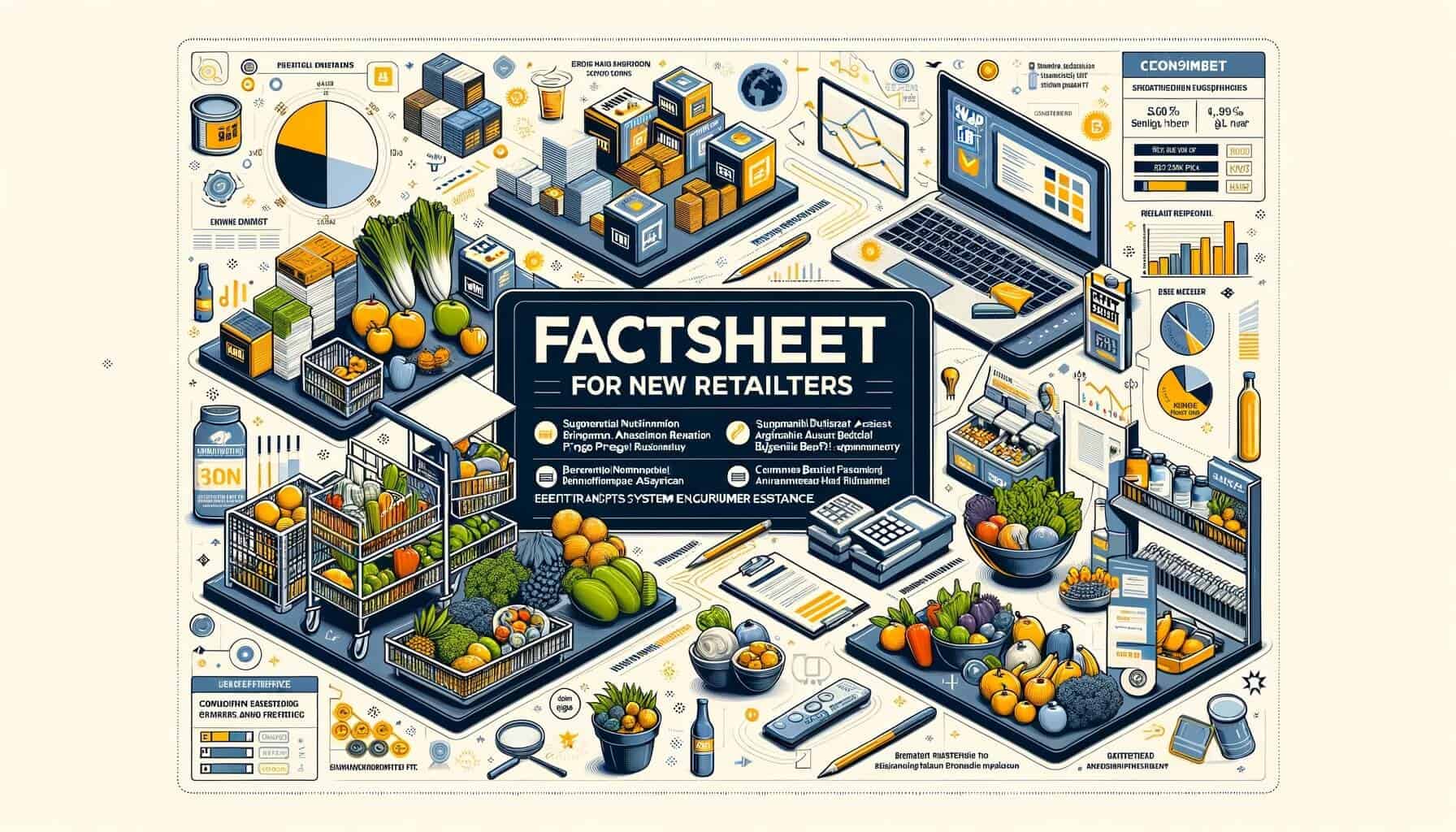
By admin April 16, 2025
The Supplemental Nutrition Assistance Program (SNAP) is a federal assistance program in the United States that provides eligible low-income individuals and families with funds to purchase food. The program is administered by the United States Department of Agriculture (USDA) and operates through an Electronic Benefit Transfer (EBT) system. SNAP EBT allows participants to use a plastic card, similar to a debit card, to make purchases at authorized retailers.
In this article, we will explore the factsheet for new retailers interested in accepting SNAP EBT and provide a comprehensive guide on how to navigate the program successfully.
Benefits of Accepting SNAP EBT as a Retailer

Accepting SNAP EBT as a retailer can bring numerous benefits to your business. Firstly, it expands your customer base by allowing you to serve low-income individuals and families who rely on SNAP benefits to purchase their groceries. According to the USDA, over 40 million people participated in SNAP in 2020, making it a significant market segment for retailers. By accepting SNAP Electronic Benefit Transfer (EBT), you can tap into this customer base and increase your sales.
Secondly, participating in the SNAP Electronic Benefit Transfer (EBT) program can enhance your store’s reputation and community standing. By accepting SNAP benefits, you demonstrate your commitment to serving all members of the community, regardless of their income level. This can help build trust and loyalty among customers, leading to repeat business and positive word-of-mouth referrals.
Additionally, retailers who accept SNAP EBT may be eligible for financial incentives. The USDA offers retailers reimbursements for certain costs associated with EBT equipment and transaction fees. These reimbursements can help offset the initial investment required to participate in the program and make it more financially viable for retailers.
Eligibility Requirements for Retailers to Accept SNAP EBT

Before applying to become an authorized SNAP EBT retailer, it is essential to understand the eligibility requirements set by the USDA. To qualify, retailers must meet the following criteria:
1. Store Type: Retailers must operate a retail food store, which includes grocery stores, supermarkets, convenience stores, and farmers markets. Non-traditional food retailers, such as meal delivery services or online-only stores, are not eligible.
2. Stock Requirements: Retailers must stock a variety of staple food items, including fruits, vegetables, dairy products, meat, poultry, fish, and bread. The USDA has specific guidelines on the minimum number of food categories and items that must be available for purchase.
3. Licensing and Permits: Retailers must comply with all federal, state, and local licensing and permit requirements. This includes obtaining the necessary permits to sell food and complying with health and safety regulations.
4. Redemption Requirements: Retailers must agree to redeem SNAP benefits by providing eligible food items to SNAP participants. This includes following proper procedures for accepting SNAP EBT payments and ensuring accurate record-keeping.
5. Sales Threshold: Retailers must meet a minimum threshold of eligible food sales to qualify for SNAP Electronic Benefit Transfer (EBT) authorization. The exact threshold varies depending on the store type and location.
How to Apply for SNAP EBT Retailer Authorization

To apply for SNAP EBT retailer authorization, follow these steps:
1. Obtain a USDA Account: Create an account on the USDA’s Food and Nutrition Service (FNS) website. This account will be used to access the online application system.
2. Complete the Application: Fill out the online application form, providing all the required information about your store, including its location, type, and stock availability. You will also need to provide details about your business structure, ownership, and any previous participation in federal assistance programs.
3. Submit Supporting Documents: Along with the application, you will need to submit supporting documents, such as your store’s licenses and permits, proof of ownership or lease agreement, and financial statements. These documents help verify your eligibility and ensure compliance with program requirements.
4. Attend a Training Session: Once your application is submitted, you may be required to attend a training session conducted by the USDA or its designated agency. This training will provide you with information on program rules, regulations, and best practices for accepting SNAP EBT.
5. Wait for Approval: After completing the application and training, you will need to wait for the USDA to review your application. The review process can take several weeks, during which the USDA may conduct site visits or request additional information. Once approved, you will receive an authorization letter and a SNAP Electronic Benefit Transfer (EBT) retailer identification number.
Understanding SNAP EBT Payment Process

Once authorized as a SNAP EBT retailer, it is crucial to understand the payment process to ensure smooth transactions with SNAP participants. Here is a step-by-step guide to understanding how SNAP EBT payments work:
1. Participant Makes a Purchase: A SNAP participant selects eligible food items and brings them to the checkout counter. The participant then presents their SNAP EBT card to the retailer.
2. Card Swipe or Entry: The retailer swipes the participant’s SNAP EBT card through an EBT card reader or manually enters the card number into the point-of-sale (POS) system.
3. Transaction Authorization: The EBT card reader or POS system sends the transaction information to the USDA’s EBT system for authorization. The system checks the participant’s account balance and verifies that the purchase is for eligible food items.
4. Approval or Denial: The USDA’s EBT system sends an approval or denial message back to the retailer’s EBT equipment. If approved, the retailer can proceed with the transaction. If denied, the retailer must inform the participant and provide an explanation.
5. Payment Deduction: Once the transaction is approved, the retailer deducts the purchase amount from the participant’s SNAP EBT account. The retailer receives payment for the transaction from the USDA through the EBT system.
6. Receipt and Balance: The retailer provides the participant with a receipt showing the items purchased, the amount deducted from their SNAP EBT account, and the remaining balance on their card.
7. Reconciliation and Reporting: Retailers are responsible for reconciling their SNAP EBT transactions and reporting them to the USDA. This includes keeping accurate records of sales, refunds, and any discrepancies.
Best Practices for Retailers Accepting SNAP EBT
To ensure a positive experience for both retailers and SNAP participants, it is essential to follow best practices when accepting SNAP EBT. Here are some tips to help you navigate the program successfully:
1. Train Staff: Provide comprehensive training to your staff on how to process SNAP EBT transactions, identify eligible food items, and handle customer inquiries. Well-trained staff can ensure smooth transactions and provide excellent customer service.
2. Display SNAP EBT Signage: Clearly display SNAP EBT signage at your store entrance and checkout counters to inform customers that you accept SNAP benefits. This helps SNAP participants identify your store as an authorized retailer.
3. Stock a Variety of Eligible Food Items: Ensure that your store stocks a wide range of eligible food items to meet the needs of SNAP participants. This includes fresh produce, dairy products, meat, poultry, fish, and bread. Consider offering affordable options and promoting healthy choices.
4. Maintain Competitive Pricing: Strive to offer competitive pricing on eligible food items to attract SNAP participants. Regularly review your pricing strategy and compare it to other retailers in your area to ensure affordability.
5. Provide Excellent Customer Service: Treat SNAP participants with respect and provide excellent customer service. Train your staff to be knowledgeable about the program and assist customers with any questions or concerns they may have.
6. Monitor Inventory and Expiration Dates: Regularly monitor your inventory to ensure that eligible food items are in stock and have not expired. This helps prevent issues during transactions and ensures that SNAP participants can purchase fresh and safe food.
7. Keep Accurate Records: Maintain accurate records of SNAP EBT transactions, including sales, refunds, and any discrepancies. This will help with reconciliation and reporting requirements and ensure compliance with program regulations.
Common Challenges and Solutions for SNAP EBT Retailers
While accepting SNAP EBT can bring numerous benefits, retailers may also face certain challenges. Here are some common challenges and solutions to help overcome them:
1. Technical Issues: Retailers may encounter technical issues with their EBT equipment or connectivity. To mitigate this, ensure that your equipment is regularly maintained and updated. Have a backup plan in place, such as manual voucher processing, in case of technical failures.
2. Training and Knowledge Gaps: Inadequate training or knowledge gaps among staff can lead to errors or delays in processing SNAP EBT transactions. Invest in comprehensive training programs and provide ongoing support to ensure that staff members are well-equipped to handle SNAP EBT transactions.
3. Compliance and Record-Keeping: Meeting the compliance and record-keeping requirements of the SNAP EBT program can be challenging for some retailers. Implement robust systems and processes to ensure accurate record-keeping and timely reporting. Consider using technology solutions that automate record-keeping and reporting tasks.
4. Inventory Management: Maintaining a diverse and well-stocked inventory of eligible food items can be a challenge, especially for smaller retailers. Develop relationships with local suppliers and wholesalers to ensure a consistent supply of eligible food items. Consider participating in programs that provide incentives for stocking fresh produce and other healthy options.
5. Customer Education: Some SNAP participants may be unfamiliar with the program or have questions about eligible food items. Educate your staff on the program’s rules and guidelines so they can provide accurate information to customers. Consider providing educational materials or hosting workshops to help SNAP participants make informed choices.
Frequently Asked Questions about SNAP EBT for Retailers
Q1. Can online retailers participate in the SNAP EBT program?
Answer: As of 2021, online retailers can participate in the SNAP EBT program through the USDA’s Online Purchasing Pilot. However, eligibility requirements and participation criteria may vary. Online retailers interested in participating should visit the USDA’s website for more information.
Q2. How long does it take to become an authorized SNAP EBT retailer?
Answer: The timeframe for becoming an authorized SNAP EBT retailer can vary. The USDA typically reviews applications within 45 days of submission. However, additional time may be required for site visits or if additional information is requested. It is advisable to submit the application well in advance to allow for any potential delays.
Q3. Can retailers charge additional fees for SNAP EBT transactions?
Answer: No, retailers are not allowed to charge additional fees for SNAP EBT transactions. The USDA prohibits any surcharges or fees associated with SNAP EBT payments. Retailers must treat SNAP EBT transactions the same as other forms of payment, such as cash or credit cards.
Q4. Can retailers refuse to accept SNAP EBT?
Answer: Retailers are not required to participate in the SNAP EBT program. However, if a retailer chooses to accept SNAP benefits, they must comply with all program rules and regulations. Once authorized, retailers cannot selectively refuse SNAP EBT transactions from eligible participants.
Q5. How can retailers check the balance on a SNAP EBT card?
Answer: Retailers can check the balance on a SNAP EBT card by using their EBT equipment or by calling the USDA’s EBT customer service hotline. The participant must provide their card number for the balance inquiry.
Conclusion
Accepting SNAP EBT as a retailer can bring numerous benefits, including expanding your customer base, enhancing your store’s reputation, and potentially qualifying for financial incentives. By understanding the eligibility requirements, application process, payment process, and best practices for retailers, you can navigate the SNAP EBT program successfully.
It is important to address common challenges and ensure compliance with program regulations to provide a positive experience for both retailers and SNAP participants. By following the guidelines outlined in this article, you can become an authorized SNAP EBT retailer and contribute to the well-being of low-income individuals and families in your community.